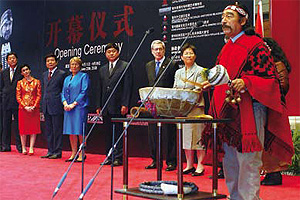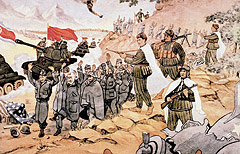Tourism is an important sector for Araucania, because it is fourth nationwide regarding the influx of foreign visitors.
Province of Malleco
– Angol: this comuna (county) has 48,966 inhabitants and is found at the foot of the Nahuelbuta mountain range, next to the Vergara river. The main tourist attractions are the Historical Museum, the cultural center, Benjamin Vicuña Mackenna plaza and the church and convent San Buenaventura.
– El Vergel: located 5 km from Angol, this tourist center has a hostal for staying overnight and a large greenhouse with fruit-bearing, forest and ornamental plants and trees. It was created in 1880 by Manuel Bunster and executed by Japanese landscapers. Currently, it the plant farm with the most amount of species in Chile, both native and exotic. Additionally, in 1962, American scientist and missionary Dillman Samuel Bullowck founded and museum next to this spot which nowadays bears his name. It keeps a valuable archeological and flora and fauna exhibit that represents the area.
– Malleco Viaduct: this railway bridge is located over the Malleco river, near Collipulli. It is 347,5 , long and 102 m high and was designed by Victorino Lastarria and pre-manufactured in welded components in France by the Schneider Co. de Le Creusot company. Mounting it took 20 months, and it was inaugurated in 1890 under the rule of Jose Manuel Balmaceda. It was declared a National Monument in 1990.
– Capitan Pastene: this location, which was founded in 1904 by Italian colonists, is found in the Nahuelbuta mountain range (comuna of Lumanco). Its population continues to preserve Italian traditions, mainly in its cuisine.
– Victoria: it is the second most populated comuna (county) in this province, with 33,501 inhabitants. It is known as the gateway to the Andes mountains. It was born as a fort in 1881 during the last campaign of the Araucania.
– Traiguen: this comuna (county), which is located 68 km from Angol, has 14,140 inhabitants. It is known as the “Granero de Chile” (Chile’s granary) due to the great production of wheat that took place here in the late XIX and early XX century. Its main tourist attractions are the Quinchanmahuida waterfall, the Los Maitenes bathing area, Chufquen ravine and the falls found in the Quino river. In addition, one may visit Weber Park, which houses over 76 varieties of conifers.
– Las Raices Tunnel: it is set in the mountain range of the same name and was built between 1929 and 1939. It is 4.5 km long and was originally for trains, but is currently paved for cars.
– Curacautin: this comuna (county), which has 16,417 inhabitants, is located along the banks of the Cautin river, in the valley bordered by the Tolhuaca, Lonquimay and Llaima volcanoes. From here, you can access several spots that are very interesting for tourists.
– Tolhuaca hot springs: located 33 km from Curacautin, it has two thermal pools. Here, one may go on hikes and walks through the beautiful forests surrounding the area.
Province of Cautin
– Temuco: it is the regional and provincial capital. It has 245,347 inhabitants and its main tourist attractions are Anibal Pinto plaza, which is home to a number of trees; the monument to the Araucania by sculptor Galvarino Ponce, which is found in the center of town; the Municipal Market, which dates back to 1929 and brings together the best cuisine and handicrafts in the region, and the Regional Museum of the Araucania, which was created in 1940. It has an ongoing exhibition that recounts the history of the region, which was dominated by the mapuche people in centuries past.
– Caburga Lake: it is found 22 km west of Pucon, has a 53 km2 surface and is of volcanic origin. Its beautiful beaches have peaceful waters and clear, white sands, unique to the south of Chile. It is surrounded by forests, and nearby, one may find the water wells called Ojos de Caburga.
– Curarrehue: 36 km from Pucon, this comuna (county) is covered by snow in winter. Its main attraction is the Trawupeyüm, an intercultural village where one may get to know the mapuche culture.
– Villarrica lake: with a surface of 173 km2, it is one of the spots most visited by the tourists. This lake, which was initially named Mallolafquen, was discovered by Pedro de Valdivia in December of 1551.
– Nueva Imperial: is is locatged 23 km from Carahue and was founded by Pedro de Valdivia in 1552. Its main attraction is the Steam Age Museum, which gathers over 40 locomotives.
– Cunco: this location, which has 8,803 inhabitants, is located 58 km from Temuco. From there, one may access Conguillio National Park and lake Colico. Within, one finds Puerto Puma bathing area, which was a lumber port last century.
The hot springs circuit
In the Cautin province there are several hot springs that one may visit. A few of them are:
– Menetue hot springs: it is located next to Ancapulli lagoon, 30 km from Pucon. It has two indoor thermal pools and two outdoor ones.
– Geometric hot springs: set within the Villarrica National Park, it is located next to the Aihue marsh, near the town of Coñaripe. It has 20 pools with waters that reach temperatures of 80ºC.
– Palguin hot springs: it is located in the Palguin Alto sector, 29 km southeast of Pucon. It has an outdoor pool and hot springs.
– Quimey-Co hot springs: it is located in the valley of the Liucura river, 31 km from Pucon. It has two outdoor thermal pools, one indoor one and two individual hot springs.
– Blanco river hot springs: it is located east of lake Caburga, 64 km from Cunco. It has a large thermal pool and several hot springs.
– Trancura hot springs: located 27 km from Pucon. It has two indoor pools and two outdoor ones. It also has eight mud pools.
– Los Pozones hot springs: it is found next to the Liucura river, 36 km from Pucon. They are known for their hot springs formed from rocks.
– San Sebastian hot springs: it borders the Blanco river hot springs, they are only separated by the body of water that bears the same name. It has a pool and several thermal hot springs.
– Liucura hot springs: it is located 19 km from Pucon, next to the Liucura river. It has an outdoor pool, an indoor pool, a hot spring pool and another one with water and mud.
– Huife hot springs: it is located 33 km from Pucon. Its pools are at the bank of the Liucura river andare surrounded by 300 hectares of native forest.
– San Luis hot springs: it is located 27 km from Pucon, in the Curarrehue valley. It has two ample thermal water pools and another outdoor pool.








 Termina la Guerra de Corea
Termina la Guerra de Corea